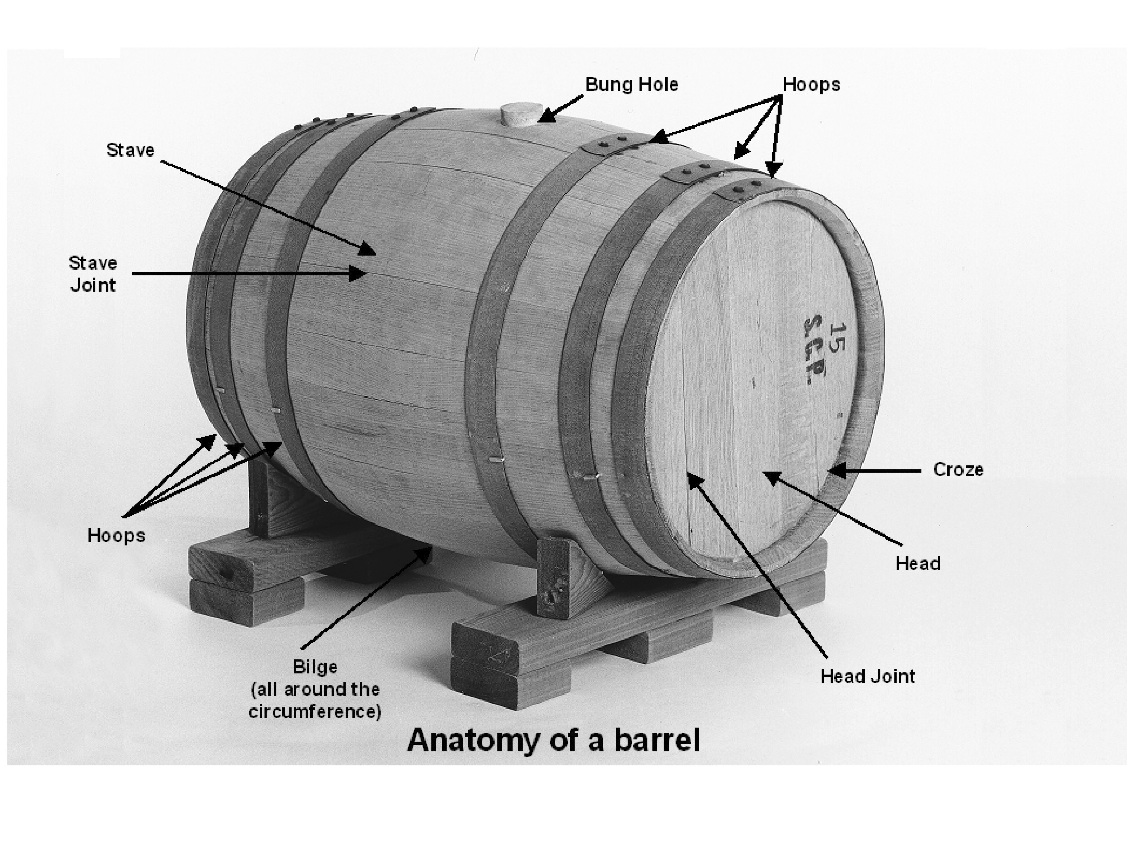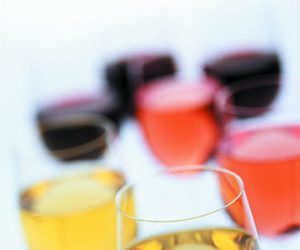
This guide provides instructions for many years of problem-free barrel use.
Buying a Barrel
When you first buy a barrel, new or used, thoroughly inspect the interior and exterior of the barrel for any potential problems. Visually inspect the interior by inserting a small light source through the bung hole. Look for any obvious wood defects, wide joint gaps, or excessively charred wood resulting from over-toasting. Barrels are toasted in an open fire during manufacturing. Toasted wood should have a smooth finish with a uniform brownish color. Charred wood will look damaged and can be easily detected because it has a very dark brown, almost black, color.
On the exterior, ensure that stave and head joints are narrow and tight, hoops are properly fastened, and the bung hole is tapered and not damaged — a source of spoilage problems. Old barrels may have a crack emanating from the bung hole, which may cause excessive oxidation of the wine.
New Barrel Maintenance
To minimize maintenance, wait to buy new barrels until you are ready to use them. Otherwise, store empty barrels in a cool and humid area, 55° F (13° C) and 65–75 percent humidity, respectively, and away from dampness, to minimize shrinkage. If the wood shrinks, stave and head joint gaps will widen and barrels will require more preparation when ready to transfer your wine.
Protect empty barrels from spoilage organisms by burning sulfur inside the barrels to replace the air with sulfur dioxide (SO2) gas. Barrels can be stored empty for an indefinite amount of time when properly preserved with sulfur. Once a month, gently sniff the inside of each barrel to determine if any SO2 gas is still present. If detected, simply replace the bung; otherwise, burn more sulfur. Be sure to work in a well-ventilated area and avoid inhaling SO2 gas.
A “sulfur bung” for burning sulfur sticks or discs can be used for this purpose. This device is used to hold burning sulfur and prevent sulfur deposits from falling into the barrel. Deposits left in the barrel will interact with wine during aging, causing hydrogen sulfide (H2S) to form. H2S will impart a rotten-egg smell and spoil the wine.
To prepare an empty barrel for storage, thoroughly rinse the interior with water and let it drain completely. No puddling of water should remain in the bilge; otherwise, it will cause sulfur dioxide gas to hydrate and form into sulfurous acid, and adversely affect the taste of wine and cause spoilage.
Light a piece of sulfur stick with a match and deposit it in the metal container at the bottom of the sulfur bung. If using a sulfur disc, place it on the hook over the metal container, and light it with a match. Insert the burning sulfur attachment in the barrel and seat the wooden bung in the hole. The sulfur will burn completely in a few minutes to fill the barrel with gas. Remove the sulfur bung and quickly insert a wooden bung to prevent gas from escaping.
New Barrel Preparation
A new barrel must be swelled with clean water before transferring wine into it; otherwise, it will leak. If wine leaks through stave or head joints, or the croze, there may be considerable wine loss. There may also be premature oxidation of the wine as air enters the barrel. Eventually, if untreated, mold will form on the exterior surface and will penetrate through the joints to contaminate the wine. By swelling barrels, all joints will tighten to eliminate any possibility of wine seepage and prevent spoilage problems.
You can swell a new barrel using a hot-water treatment or using an overnight water-soaking treatment. First, let all the SO2 gas out and thoroughly rinse the inside of the barrel with lukewarm water.
The hot-water treatment method is very effective and requires little water. Pour approximately a 20 percent volume of very hot, steamy, clean tap water into the barrel. For example, use three gallons (11 L) of hot water for a 15-gallon (57 L) barrel. Bung the barrel and slosh it around to soak the entire interior surface. The vapor pressure and hot water significantly accelerate barrel swelling and “plug” any seepage through joints. Continue sloshing the barrel until there is no more leakage. Then place it upright and let the head area soak until there is no more leakage, and repeat with the other head area. When done, let the water drain completely and let the barrel dry and cool down before transferring wine into it. If the barrel does not stop leaking within one hour of pouring the hot water, proceed with an overnight treatment.
The overnight treatment will always fix any leakage (unless the barrel is defective) although it will leach out some of the oak flavor owing to the longer soak period. This is fine for new barrels because you may want to reduce the amount of oak that will be imparted to that first batch of wine. The overnight treatment is also the best method for swelling a barrel that has been in dry storage for a long time.
Fill the barrel to the top with cool water and let it soak overnight. Initially, the barrel may leak but it should stop after a few hours or a day, or up to several days for very dry barrels. The soak period should never exceed 24–36 hours with the same water to avoid mold developing and penetrating the barrel. If there is still leakage, empty the barrel and fill it again with clean cool water, and repeat again until leakage stops. If leakage does not stop after four to five days, the barrel is defective and should be returned to your supplier. When leakage has stopped, drain the water out of the barrel by placing it in the bung-down position. Let the barrel stand for an hour or two and then fill it immediately with wine.
The barrel’s exterior surface requires no special preparation, although you should inspect it regularly for any mold. Optionally, it can be treated with Mildewcide to inhibit mold and wood borers by applying two coats with a paintbrush. Mildewcide is available from winemaking shops or coopers at a cost of under $10 for a 16-ounce (454 g) container.
Used Barrel Storage, Maintenance and Preparation
Used (sound) barrels must also be properly stored and maintained; however, since these previously contained wine, a different maintenance program is recommended.
If used barrels are to be stored empty, rinse them several times with clean water, drain and then burn sulfur inside. Check for the presence of SO2 gas once a month, and replenish as required. The disadvantage of this method is that the barrel wood will dry and shrink over time, and will therefore require to be swelled again when transferring wine into it.
An effective alternative is to fill and store barrels with a sulfur-citric holding solution. This holding solution will promote sterility, keep the barrels swelled and smelling sweet. It is not recommended for new barrels or barrels less than one year old as precious oak extract would be stripped.
The holding solution is prepared using 1 tsp of citric acid and 1.5 tsp of potassium metabisulfite for each gallon (4 L) of barrel volume. For example, for a 15-gallon (57 L) barrel, use 15 tsp of citric acid and 23 tsp of potassium metabisulfite. (Note: 3 tsp = 1 tbsp) Dissolve these in one gallon of hot water. Fill the barrel two-thirds with water, add the holding solution, top up the barrel with cool water, and bung the barrel. Top up the barrel with a holding solution once a month to replace solution lost by evaporation and absorption into the wood. The barrel can be stored indefinitely without the risk of spoilage. During storage, rotate the barrel 45° in either direction every time you top up to keep the bung area soaked. This will prevent the bung area from drying out and protect it from spoilage organism growth. Caution: The sulfur-citric holding solution will etch a concrete floor. Rinse the floor with water to prevent this.
Used barrels require no special preparation beyond a simple water rinse, if desired, when transferring wine out and in immediately. If the barrel has been stored with a holding solution, drain the barrel and rinse it thoroughly with clean water before transferring wine into it.
Types of Barrel Spoilage Problems
Oak barrels will not cause any problems when properly maintained. In improperly maintained barrels, however, spoilage problems can occur because wood is a good breeding medium for bacteria and other spoilage organisms, especially in the presence of water or wine.
Penicillium mold — a blue-green fungus causing foul-smelling odors when it interacts with wine — is the most common spoilage problem and can be very difficult to eradicate if widespread. Typically, it will grow through stave or head joints, or the croze, and around the bung hole in barrels that have not been properly swelled prior to transferring wine.
Another common source of spoilage is Acetobacter (acetic acid bacteria), which cause alcohol to be converted to acetic acid when wine oxidizes in barrels having a headspace. Acetic acid will cause volatile acidity (VA) and can be detected as the familiar vinegar smell.
The spoilage problem can also occur in empty barrels that have not been properly rinsed or sulfured during barrel storage, and where some wine residues were left behind. As this problem grows, the acetic acid combines with alcohol residues to form ethyl acetate, which smells distinctly like nail-polish remover and is very difficult to eradicate.
Brettanomyces yeasts resident in barrels are another source of problems. These spoilage yeasts can metabolize extremely low levels of sugar in wines, even wood cellulose sugars in new barrels. They result from insufficient sulfiting of wines or insufficient sulfuring of empty barrels during storage. Advanced yeast spoilage will cause a wine or barrel to take on a “medicine cabinet” smell.
Lactobacillis and Pediococcus (types of lactic acid bacteria) resident in barrels can also cause spoilage in wines with a very high pH (above 3.7) and a very low level of sulfite. They can also cause spoilage in wines with residual sugar. These bacteria thrive in such an environment and can impart a sour-milk taste to wine. They are best inhibited by maintaining at least 70 mg/L of free SO2 in wines and by periodically racking the wine from its lees.
Dealing with Spoilage Problems
To treat any of the above spoilage problems, first fill the barrel two-thirds with cool water. Prepare an alkaline solution by dissolving either sodium carbonate or sodium percarbonate in water at a rate of 1 tsp per gallon (or use 1 g/L) for mild spoilage problems or up to a maximum of 3 tsp for more serious problems. Add the solution to the barrel and then top up with water.
Let the barrel soak overnight, empty it and neutralize any remaining alkaline residues using a citric acid solution. Trace residues of sodium carbonate or sodium percarbonate are not harmful but they will affect the taste of wine if allowed to come into contact with it. Prepare the citric acid solution by dissolving citric acid powder in one gallon of water. Use 1 tsp. of powder for each gallon of barrel volume. For example, dissolve 15 tsp for a 15-gallon (57 L) barrel.
Fill the barrel two-thirds with cool water, pour in the citric acid solution, top up with cool water, and let the barrel soak overnight. Then, empty the barrel and rinse it thoroughly. Drain the water completely and let the barrel dry. Smell the barrel for any off odors to ensure the treatment worked. If the barrel does not smell completely clean, repeat the treatment as required. Discard the barrel if the problem cannot be eliminated. Don’t risk spoiling a perfect batch of wine.



